Evaluating Cultural Competence in Diverse Nursing Scenarios
VerifiedAdded on 2023/06/11
|7
|1460
|301
Case Study
AI Summary
This nursing assignment presents a series of scenarios that explore cultural competence in healthcare settings. The scenarios cover various issues such as racial discrimination, ethnocentrism, communication barriers with Aboriginal patients, and religious considerations. The solutions provided emphasize the importance of cultural sensitivity, adherence to ethical and legal standards, and the need for healthcare professionals to adapt their practices to respect diverse cultural beliefs and practices. The assignment also highlights strategies for fostering a culturally safe workplace and improving communication with patients from different cultural backgrounds, stressing the importance of training, open communication, and respect for individual beliefs and customs. Desklib offers a range of study tools and solved assignments to support students in mastering these critical aspects of nursing practice.
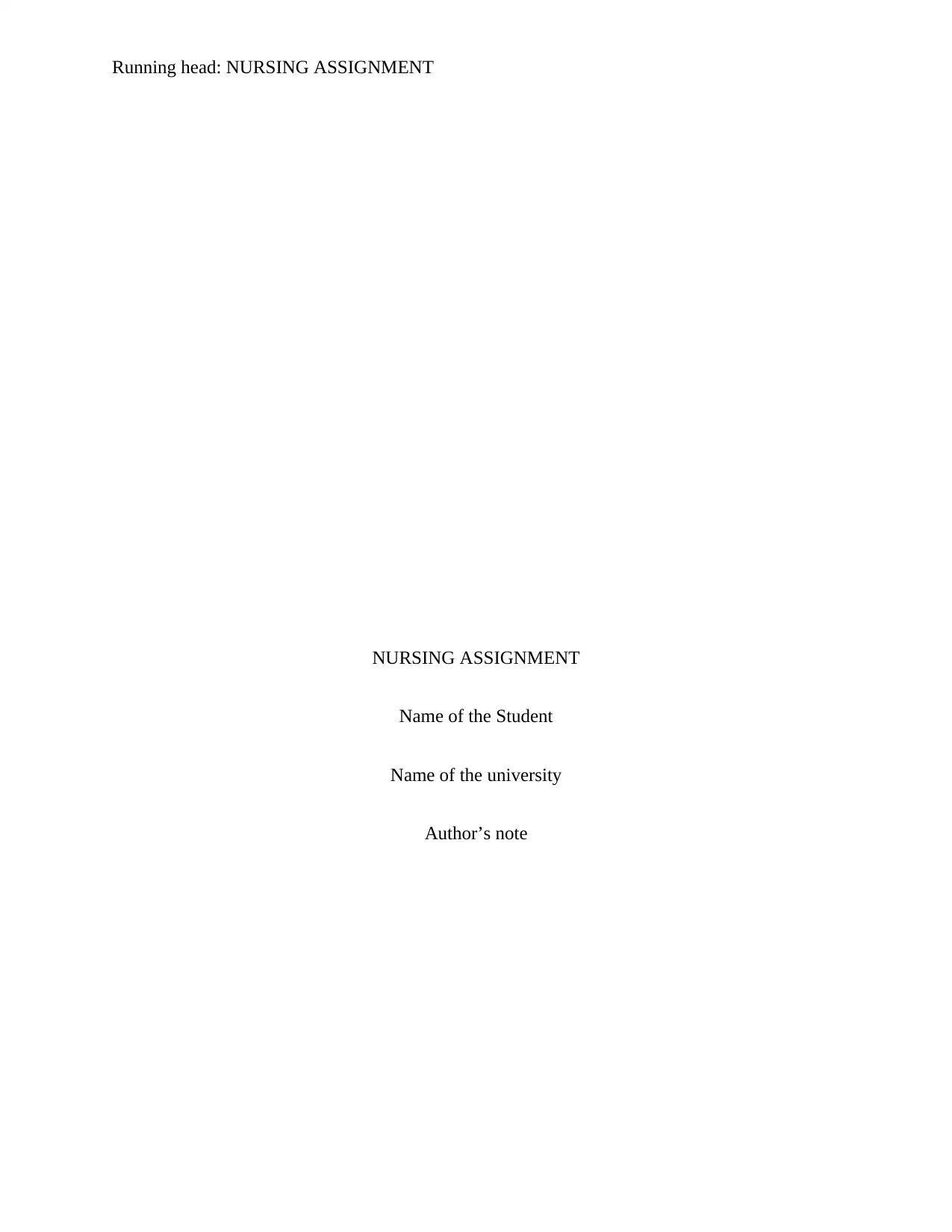
Running head: NURSING ASSIGNMENT
NURSING ASSIGNMENT
Name of the Student
Name of the university
Author’s note
NURSING ASSIGNMENT
Name of the Student
Name of the university
Author’s note
Paraphrase This Document
Need a fresh take? Get an instant paraphrase of this document with our AI Paraphraser
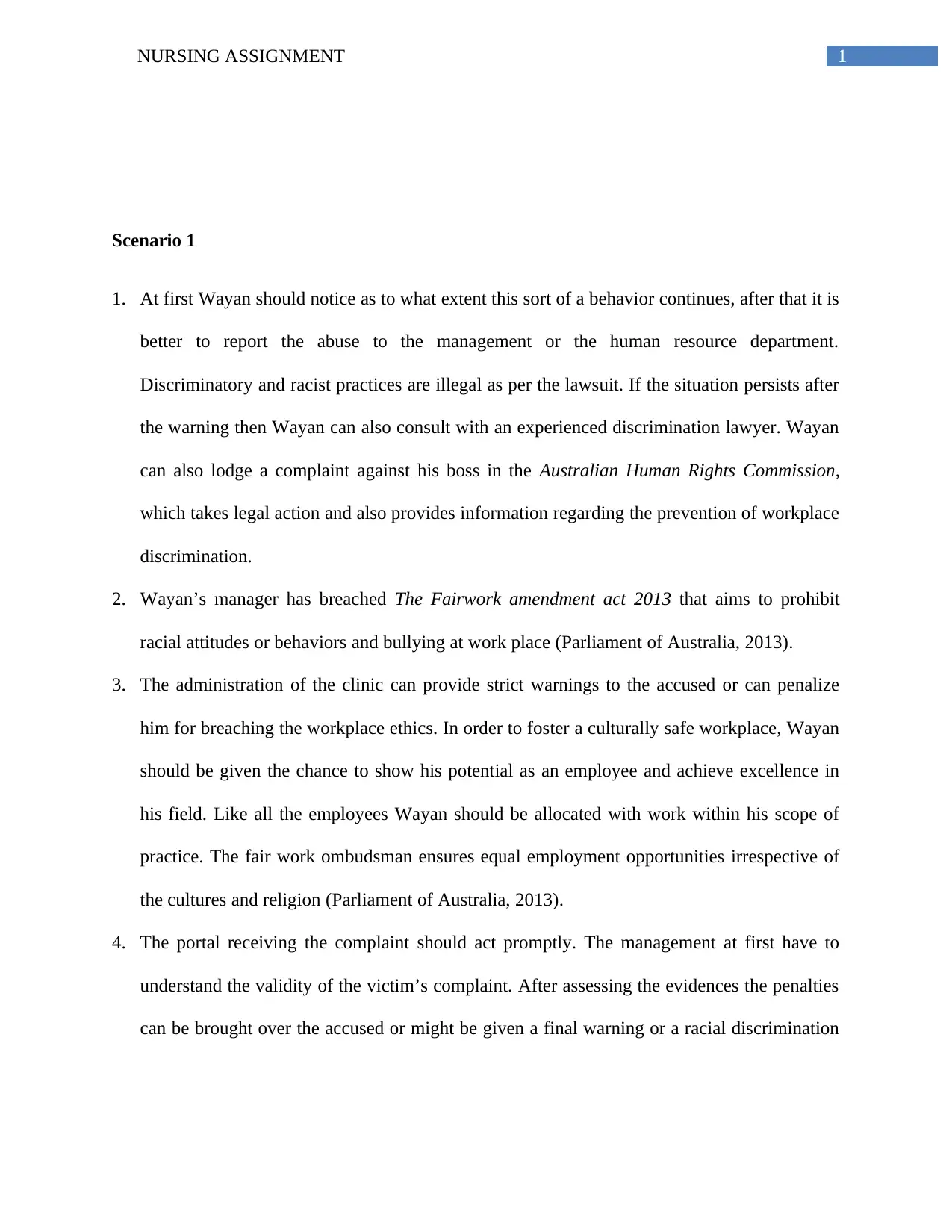
1NURSING ASSIGNMENT
Scenario 1
1. At first Wayan should notice as to what extent this sort of a behavior continues, after that it is
better to report the abuse to the management or the human resource department.
Discriminatory and racist practices are illegal as per the lawsuit. If the situation persists after
the warning then Wayan can also consult with an experienced discrimination lawyer. Wayan
can also lodge a complaint against his boss in the Australian Human Rights Commission,
which takes legal action and also provides information regarding the prevention of workplace
discrimination.
2. Wayan’s manager has breached The Fairwork amendment act 2013 that aims to prohibit
racial attitudes or behaviors and bullying at work place (Parliament of Australia, 2013).
3. The administration of the clinic can provide strict warnings to the accused or can penalize
him for breaching the workplace ethics. In order to foster a culturally safe workplace, Wayan
should be given the chance to show his potential as an employee and achieve excellence in
his field. Like all the employees Wayan should be allocated with work within his scope of
practice. The fair work ombudsman ensures equal employment opportunities irrespective of
the cultures and religion (Parliament of Australia, 2013).
4. The portal receiving the complaint should act promptly. The management at first have to
understand the validity of the victim’s complaint. After assessing the evidences the penalties
can be brought over the accused or might be given a final warning or a racial discrimination
Scenario 1
1. At first Wayan should notice as to what extent this sort of a behavior continues, after that it is
better to report the abuse to the management or the human resource department.
Discriminatory and racist practices are illegal as per the lawsuit. If the situation persists after
the warning then Wayan can also consult with an experienced discrimination lawyer. Wayan
can also lodge a complaint against his boss in the Australian Human Rights Commission,
which takes legal action and also provides information regarding the prevention of workplace
discrimination.
2. Wayan’s manager has breached The Fairwork amendment act 2013 that aims to prohibit
racial attitudes or behaviors and bullying at work place (Parliament of Australia, 2013).
3. The administration of the clinic can provide strict warnings to the accused or can penalize
him for breaching the workplace ethics. In order to foster a culturally safe workplace, Wayan
should be given the chance to show his potential as an employee and achieve excellence in
his field. Like all the employees Wayan should be allocated with work within his scope of
practice. The fair work ombudsman ensures equal employment opportunities irrespective of
the cultures and religion (Parliament of Australia, 2013).
4. The portal receiving the complaint should act promptly. The management at first have to
understand the validity of the victim’s complaint. After assessing the evidences the penalties
can be brought over the accused or might be given a final warning or a racial discrimination
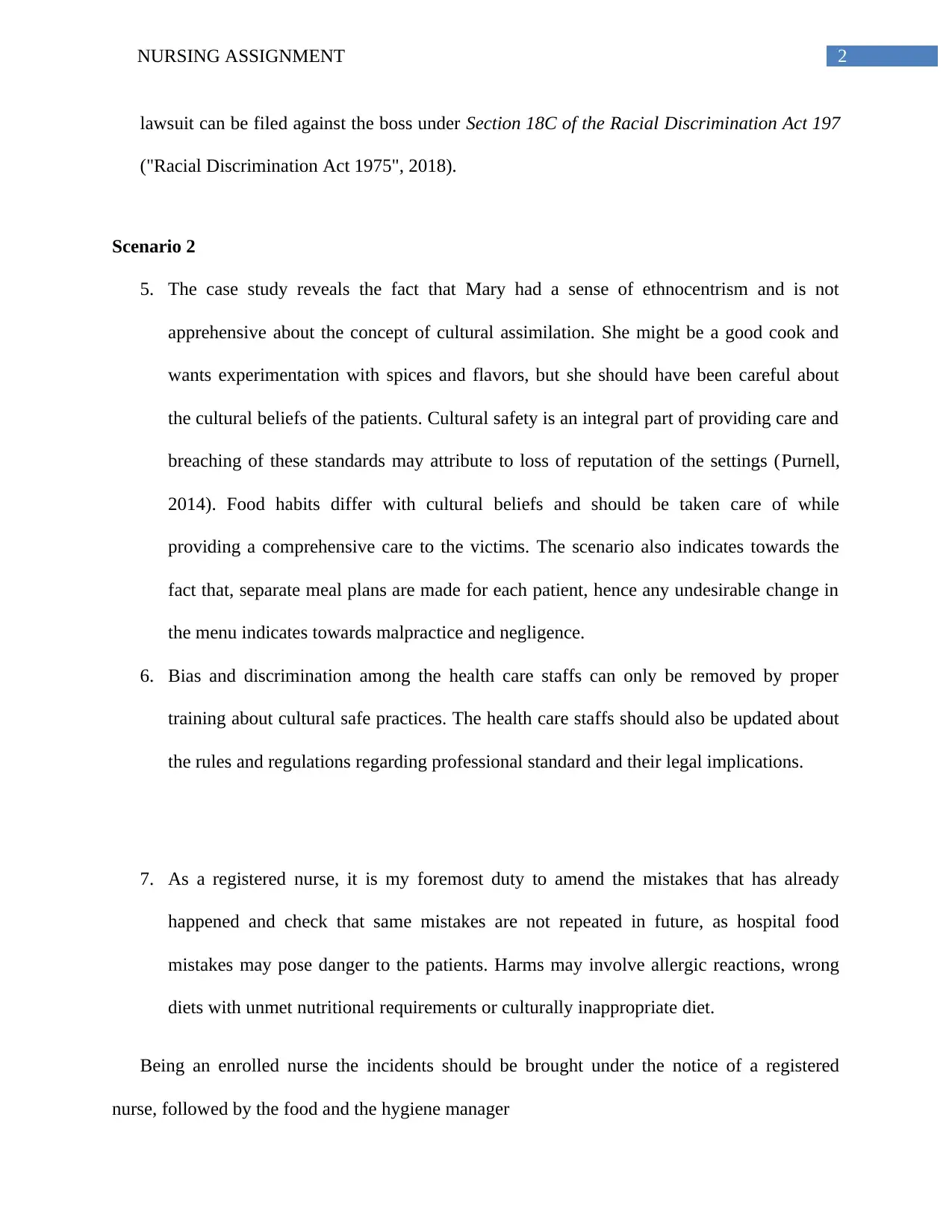
2NURSING ASSIGNMENT
lawsuit can be filed against the boss under Section 18C of the Racial Discrimination Act 197
("Racial Discrimination Act 1975", 2018).
Scenario 2
5. The case study reveals the fact that Mary had a sense of ethnocentrism and is not
apprehensive about the concept of cultural assimilation. She might be a good cook and
wants experimentation with spices and flavors, but she should have been careful about
the cultural beliefs of the patients. Cultural safety is an integral part of providing care and
breaching of these standards may attribute to loss of reputation of the settings (Purnell,
2014). Food habits differ with cultural beliefs and should be taken care of while
providing a comprehensive care to the victims. The scenario also indicates towards the
fact that, separate meal plans are made for each patient, hence any undesirable change in
the menu indicates towards malpractice and negligence.
6. Bias and discrimination among the health care staffs can only be removed by proper
training about cultural safe practices. The health care staffs should also be updated about
the rules and regulations regarding professional standard and their legal implications.
7. As a registered nurse, it is my foremost duty to amend the mistakes that has already
happened and check that same mistakes are not repeated in future, as hospital food
mistakes may pose danger to the patients. Harms may involve allergic reactions, wrong
diets with unmet nutritional requirements or culturally inappropriate diet.
Being an enrolled nurse the incidents should be brought under the notice of a registered
nurse, followed by the food and the hygiene manager
lawsuit can be filed against the boss under Section 18C of the Racial Discrimination Act 197
("Racial Discrimination Act 1975", 2018).
Scenario 2
5. The case study reveals the fact that Mary had a sense of ethnocentrism and is not
apprehensive about the concept of cultural assimilation. She might be a good cook and
wants experimentation with spices and flavors, but she should have been careful about
the cultural beliefs of the patients. Cultural safety is an integral part of providing care and
breaching of these standards may attribute to loss of reputation of the settings (Purnell,
2014). Food habits differ with cultural beliefs and should be taken care of while
providing a comprehensive care to the victims. The scenario also indicates towards the
fact that, separate meal plans are made for each patient, hence any undesirable change in
the menu indicates towards malpractice and negligence.
6. Bias and discrimination among the health care staffs can only be removed by proper
training about cultural safe practices. The health care staffs should also be updated about
the rules and regulations regarding professional standard and their legal implications.
7. As a registered nurse, it is my foremost duty to amend the mistakes that has already
happened and check that same mistakes are not repeated in future, as hospital food
mistakes may pose danger to the patients. Harms may involve allergic reactions, wrong
diets with unmet nutritional requirements or culturally inappropriate diet.
Being an enrolled nurse the incidents should be brought under the notice of a registered
nurse, followed by the food and the hygiene manager
⊘ This is a preview!⊘
Do you want full access?
Subscribe today to unlock all pages.

Trusted by 1+ million students worldwide
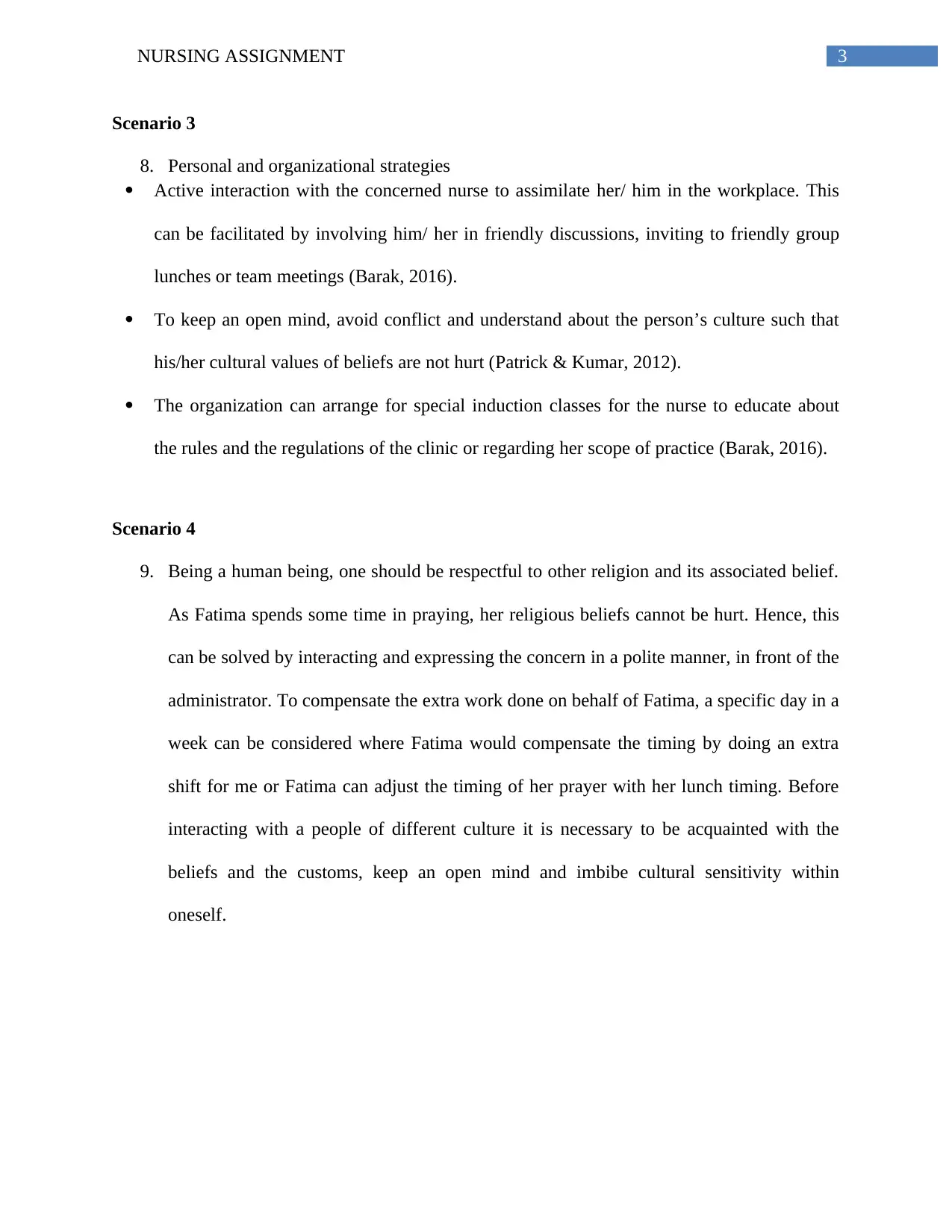
3NURSING ASSIGNMENT
Scenario 3
8. Personal and organizational strategies
Active interaction with the concerned nurse to assimilate her/ him in the workplace. This
can be facilitated by involving him/ her in friendly discussions, inviting to friendly group
lunches or team meetings (Barak, 2016).
To keep an open mind, avoid conflict and understand about the person’s culture such that
his/her cultural values of beliefs are not hurt (Patrick & Kumar, 2012).
The organization can arrange for special induction classes for the nurse to educate about
the rules and the regulations of the clinic or regarding her scope of practice (Barak, 2016).
Scenario 4
9. Being a human being, one should be respectful to other religion and its associated belief.
As Fatima spends some time in praying, her religious beliefs cannot be hurt. Hence, this
can be solved by interacting and expressing the concern in a polite manner, in front of the
administrator. To compensate the extra work done on behalf of Fatima, a specific day in a
week can be considered where Fatima would compensate the timing by doing an extra
shift for me or Fatima can adjust the timing of her prayer with her lunch timing. Before
interacting with a people of different culture it is necessary to be acquainted with the
beliefs and the customs, keep an open mind and imbibe cultural sensitivity within
oneself.
Scenario 3
8. Personal and organizational strategies
Active interaction with the concerned nurse to assimilate her/ him in the workplace. This
can be facilitated by involving him/ her in friendly discussions, inviting to friendly group
lunches or team meetings (Barak, 2016).
To keep an open mind, avoid conflict and understand about the person’s culture such that
his/her cultural values of beliefs are not hurt (Patrick & Kumar, 2012).
The organization can arrange for special induction classes for the nurse to educate about
the rules and the regulations of the clinic or regarding her scope of practice (Barak, 2016).
Scenario 4
9. Being a human being, one should be respectful to other religion and its associated belief.
As Fatima spends some time in praying, her religious beliefs cannot be hurt. Hence, this
can be solved by interacting and expressing the concern in a polite manner, in front of the
administrator. To compensate the extra work done on behalf of Fatima, a specific day in a
week can be considered where Fatima would compensate the timing by doing an extra
shift for me or Fatima can adjust the timing of her prayer with her lunch timing. Before
interacting with a people of different culture it is necessary to be acquainted with the
beliefs and the customs, keep an open mind and imbibe cultural sensitivity within
oneself.
Paraphrase This Document
Need a fresh take? Get an instant paraphrase of this document with our AI Paraphraser
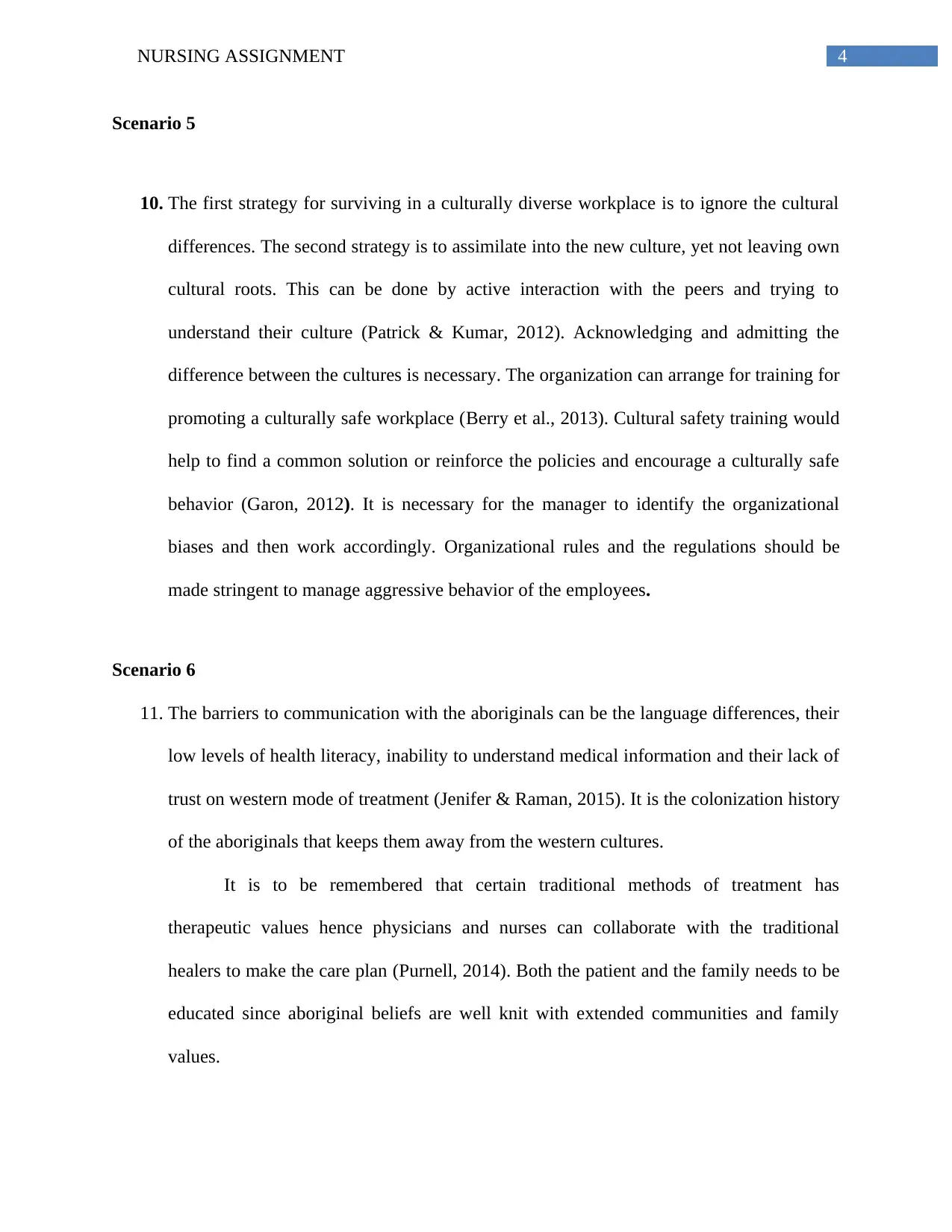
4NURSING ASSIGNMENT
Scenario 5
10. The first strategy for surviving in a culturally diverse workplace is to ignore the cultural
differences. The second strategy is to assimilate into the new culture, yet not leaving own
cultural roots. This can be done by active interaction with the peers and trying to
understand their culture (Patrick & Kumar, 2012). Acknowledging and admitting the
difference between the cultures is necessary. The organization can arrange for training for
promoting a culturally safe workplace (Berry et al., 2013). Cultural safety training would
help to find a common solution or reinforce the policies and encourage a culturally safe
behavior (Garon, 2012). It is necessary for the manager to identify the organizational
biases and then work accordingly. Organizational rules and the regulations should be
made stringent to manage aggressive behavior of the employees.
Scenario 6
11. The barriers to communication with the aboriginals can be the language differences, their
low levels of health literacy, inability to understand medical information and their lack of
trust on western mode of treatment (Jenifer & Raman, 2015). It is the colonization history
of the aboriginals that keeps them away from the western cultures.
It is to be remembered that certain traditional methods of treatment has
therapeutic values hence physicians and nurses can collaborate with the traditional
healers to make the care plan (Purnell, 2014). Both the patient and the family needs to be
educated since aboriginal beliefs are well knit with extended communities and family
values.
Scenario 5
10. The first strategy for surviving in a culturally diverse workplace is to ignore the cultural
differences. The second strategy is to assimilate into the new culture, yet not leaving own
cultural roots. This can be done by active interaction with the peers and trying to
understand their culture (Patrick & Kumar, 2012). Acknowledging and admitting the
difference between the cultures is necessary. The organization can arrange for training for
promoting a culturally safe workplace (Berry et al., 2013). Cultural safety training would
help to find a common solution or reinforce the policies and encourage a culturally safe
behavior (Garon, 2012). It is necessary for the manager to identify the organizational
biases and then work accordingly. Organizational rules and the regulations should be
made stringent to manage aggressive behavior of the employees.
Scenario 6
11. The barriers to communication with the aboriginals can be the language differences, their
low levels of health literacy, inability to understand medical information and their lack of
trust on western mode of treatment (Jenifer & Raman, 2015). It is the colonization history
of the aboriginals that keeps them away from the western cultures.
It is to be remembered that certain traditional methods of treatment has
therapeutic values hence physicians and nurses can collaborate with the traditional
healers to make the care plan (Purnell, 2014). Both the patient and the family needs to be
educated since aboriginal beliefs are well knit with extended communities and family
values.
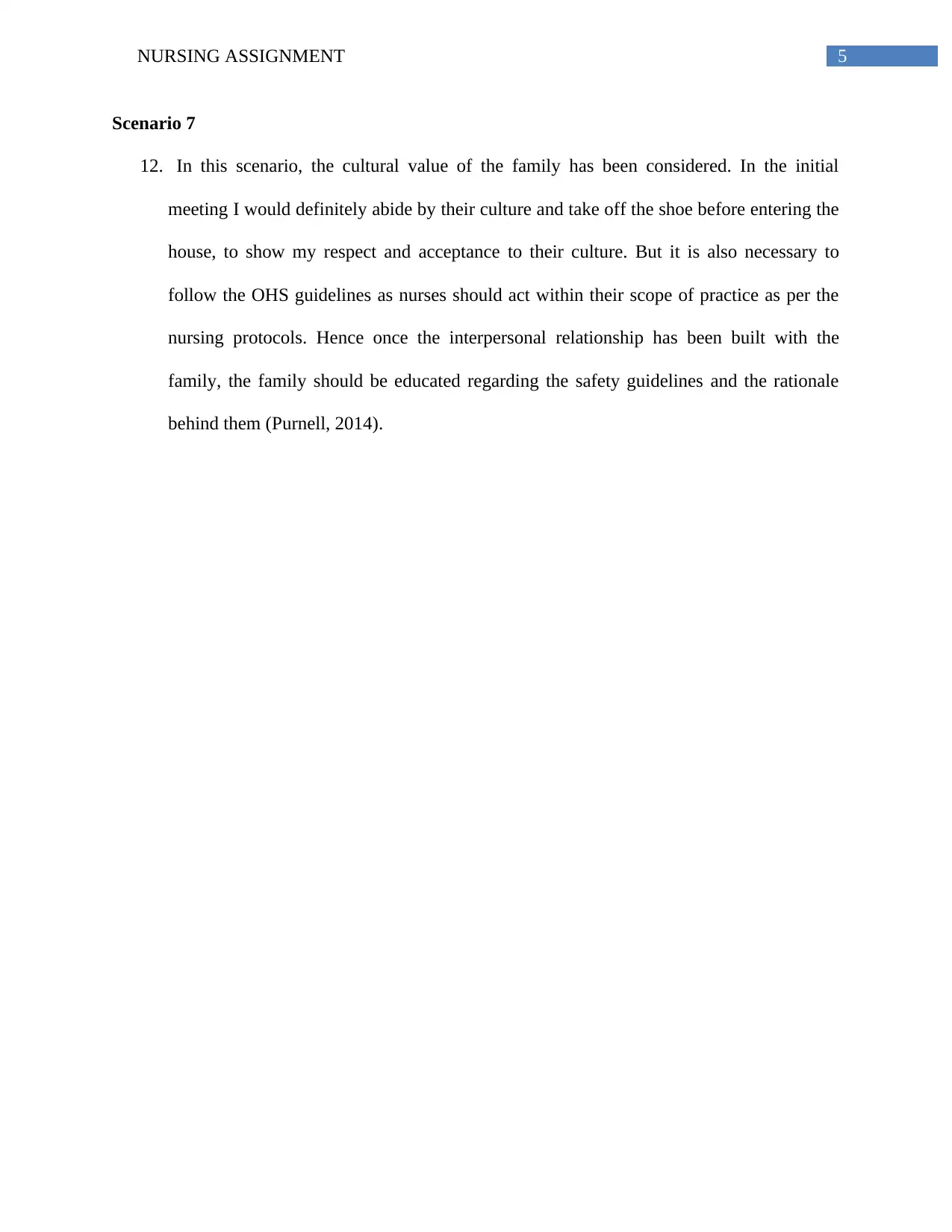
5NURSING ASSIGNMENT
Scenario 7
12. In this scenario, the cultural value of the family has been considered. In the initial
meeting I would definitely abide by their culture and take off the shoe before entering the
house, to show my respect and acceptance to their culture. But it is also necessary to
follow the OHS guidelines as nurses should act within their scope of practice as per the
nursing protocols. Hence once the interpersonal relationship has been built with the
family, the family should be educated regarding the safety guidelines and the rationale
behind them (Purnell, 2014).
Scenario 7
12. In this scenario, the cultural value of the family has been considered. In the initial
meeting I would definitely abide by their culture and take off the shoe before entering the
house, to show my respect and acceptance to their culture. But it is also necessary to
follow the OHS guidelines as nurses should act within their scope of practice as per the
nursing protocols. Hence once the interpersonal relationship has been built with the
family, the family should be educated regarding the safety guidelines and the rationale
behind them (Purnell, 2014).
⊘ This is a preview!⊘
Do you want full access?
Subscribe today to unlock all pages.

Trusted by 1+ million students worldwide
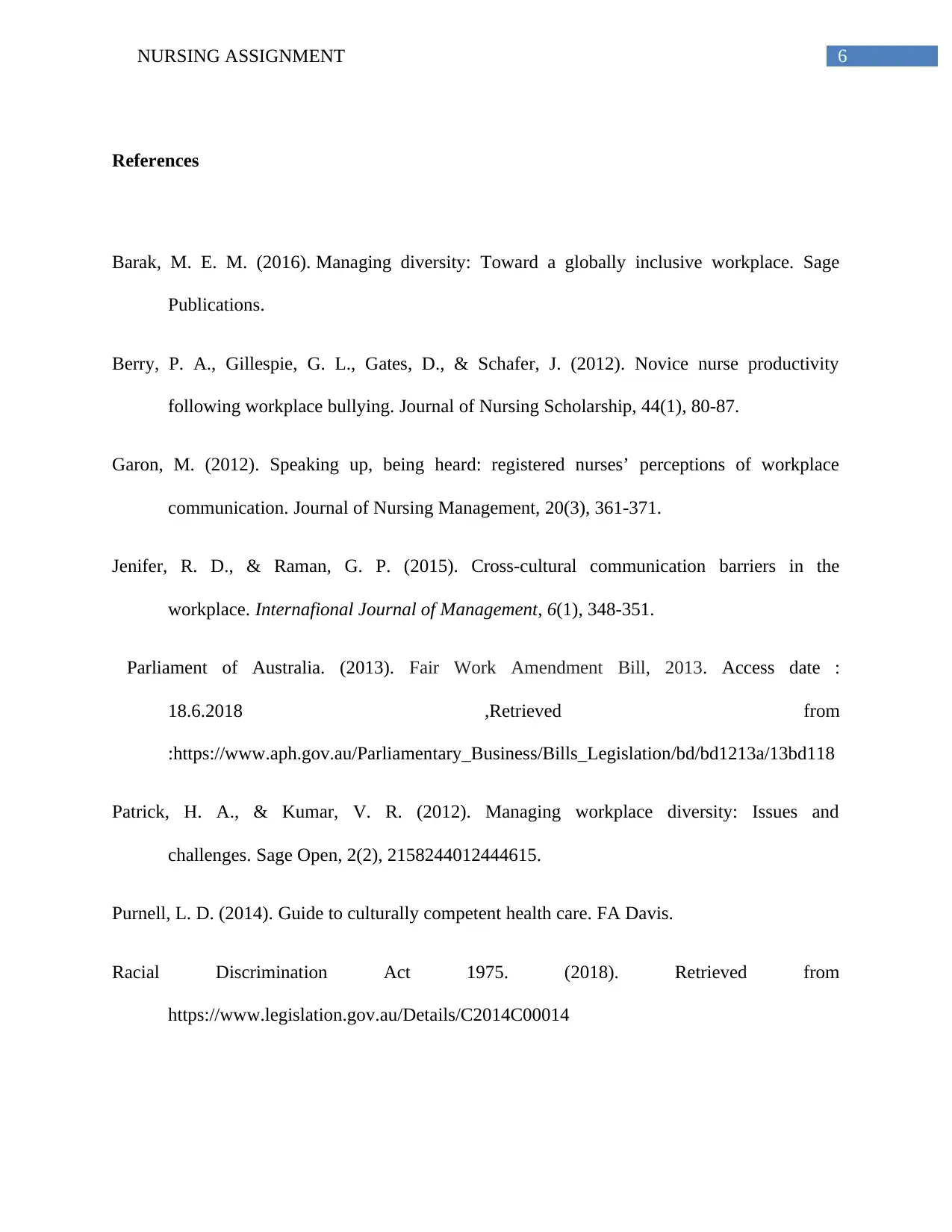
6NURSING ASSIGNMENT
References
Barak, M. E. M. (2016). Managing diversity: Toward a globally inclusive workplace. Sage
Publications.
Berry, P. A., Gillespie, G. L., Gates, D., & Schafer, J. (2012). Novice nurse productivity
following workplace bullying. Journal of Nursing Scholarship, 44(1), 80-87.
Garon, M. (2012). Speaking up, being heard: registered nurses’ perceptions of workplace
communication. Journal of Nursing Management, 20(3), 361-371.
Jenifer, R. D., & Raman, G. P. (2015). Cross-cultural communication barriers in the
workplace. Internafional Journal of Management, 6(1), 348-351.
Parliament of Australia. (2013). Fair Work Amendment Bill, 2013. Access date :
18.6.2018 ,Retrieved from
:https://www.aph.gov.au/Parliamentary_Business/Bills_Legislation/bd/bd1213a/13bd118
Patrick, H. A., & Kumar, V. R. (2012). Managing workplace diversity: Issues and
challenges. Sage Open, 2(2), 2158244012444615.
Purnell, L. D. (2014). Guide to culturally competent health care. FA Davis.
Racial Discrimination Act 1975. (2018). Retrieved from
https://www.legislation.gov.au/Details/C2014C00014
References
Barak, M. E. M. (2016). Managing diversity: Toward a globally inclusive workplace. Sage
Publications.
Berry, P. A., Gillespie, G. L., Gates, D., & Schafer, J. (2012). Novice nurse productivity
following workplace bullying. Journal of Nursing Scholarship, 44(1), 80-87.
Garon, M. (2012). Speaking up, being heard: registered nurses’ perceptions of workplace
communication. Journal of Nursing Management, 20(3), 361-371.
Jenifer, R. D., & Raman, G. P. (2015). Cross-cultural communication barriers in the
workplace. Internafional Journal of Management, 6(1), 348-351.
Parliament of Australia. (2013). Fair Work Amendment Bill, 2013. Access date :
18.6.2018 ,Retrieved from
:https://www.aph.gov.au/Parliamentary_Business/Bills_Legislation/bd/bd1213a/13bd118
Patrick, H. A., & Kumar, V. R. (2012). Managing workplace diversity: Issues and
challenges. Sage Open, 2(2), 2158244012444615.
Purnell, L. D. (2014). Guide to culturally competent health care. FA Davis.
Racial Discrimination Act 1975. (2018). Retrieved from
https://www.legislation.gov.au/Details/C2014C00014
1 out of 7
Your All-in-One AI-Powered Toolkit for Academic Success.
+13062052269
info@desklib.com
Available 24*7 on WhatsApp / Email
![[object Object]](/_next/static/media/star-bottom.7253800d.svg)
Unlock your academic potential
Copyright © 2020–2025 A2Z Services. All Rights Reserved. Developed and managed by ZUCOL.